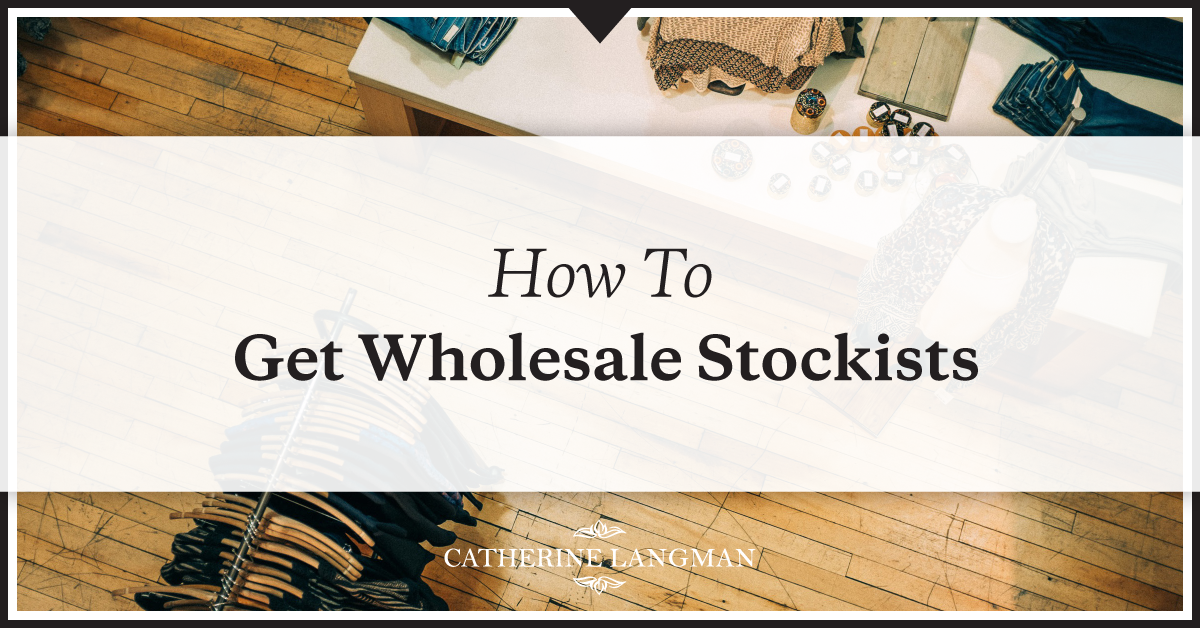https://www.catherinelangman.com/how-to-get-wholesale-stockists-in-6-simple-steps/
Are you ready to find wholesale stockists for your products? Or a product designer, brand owner or distributor considering taking the plunge into wholesale?
I don’t know about you, but when I first got into the business of wholesale, I did question the logic of selling my products at such a reduced price. It does seem more profitable to sell at full price direct to the consumer, right?
But, selling wholesale to other retailers (both online and bricks ‘n mortar) can be very lucrative if you get it right.
Build brand awareness (aka become well known!)
Building your business and brand online means building an audience, attracting customers, one at a time. Sure you can use technology and paid traffic to speed this up a bit.
But stocking into a bunch of other retail stores is a sure-fire way to become instantly better known. All of a sudden your ideal customers are seeing your brand all over the place!
Get bigger orders
Sure, selling individual products direct to customers at full RRP has a much higher gross profit. BUT, it doesn’t take much time to fulfil a wholesale order compared to a retail order, AND those orders are gonna be way way bigger.
Get consistent orders
One of the best things I found about selling wholesale was that most stockists would place monthly orders. Nothing better than getting a consistent paycheck!
Simplify & grow your business
The thing I like best about adding wholesale alongside direct-to-consumer retail sales, is that wholesale is a much simpler business model.
It’s much easier to manage a handful of customers buying bigger, more frequent orders, compared to lots and lots of individual customers buying smaller orders on an ad hoc basis. So with bigger and more consistent sales, your business will grow overall.
Here’s how to get cracking with my 6 simple steps to getting wholesale stockists

Step 1: The Price Is Right
The first thing you need to figure out is – what to charge for your wholesale price.
Most retailers expect a 100% mark-up from wholesale to RRP. (Or to look at it the other way around – your wholesale price is 50% off your RRP.)
Some industries, like grocery and pharmacy, often work off smaller margins (40% off RRP is common).
Secondly, decide whether you want to impose any conditions on ordering, such as minimum order quantities or minimum order value.
Grab my free wholesale price list and order form template (which you can edit in Excel).
Step 2: Present Like A Pro
When you approach a retailer, it’s important to appear professional. If your stuff looks like your kid’s 5th grade homework, it won’t be appealing… Think of it from the retailer’s perspective – they want to be sure their customers will be attracted to your products and buy them!
Photography
At least have your products shot on a white background and/or deep etched to delete the background around the products. This immediately makes your products look more professional.
Packaging
If you want to sell into bricks & mortar stores, you’ll need to consider packaging. Most retailers have standardized retail displays, whether on shelves or hang-sells. Your products need to fit within the store’s method of merchandising.
Printed materials
Spend a few dollars to have your wholesale range brochure professionally designed (with your new pro photos as well).
Step 3: Who Are You Selling To?
The first thing you need to do is figure out who buys your stuff by defining your ideal customer. Then, work out where that person shops!
I like to create a bit of a profile of your ideal retail store as well, because this makes it easier to decide whether a store is worth approaching or not.
Step 4: Make A Direct Approach
The biggest mistake many brand owners and distributors make is waiting for retailers to approach them. Whether that’s because they’re too shy to make the approach or have no idea how to do it.
Sadly, waiting to be discovered is no way to grow a business! In my experience, you gotta get out there and make the approach.
- Calling retailers
- Emailing retailers
- Send printed material to retailers
- Knocking on doors
Bottom line – you have to make yourself known to retailers!
Step 5: Get Repeat Orders
The second biggest mistake they make? Not getting repeat orders from their wholesale stockists.
Business owners say to me all the time – I don’t know how to keep my retailers engaged and re-ordering.
The golden rule is to follow up with your stockists. Don’t just hang around waiting for them to get back in touch with you with another order.
Contact them monthly – even if it’s just to chat with them and see how things are going. They’ll appreciate you making the effort to build up a bit of a relationship with them!
Step 5: Marketing to Consumers
Now, you may be thinking that just because you’re wholesaling you don’t have to put any effort into marketing to the end consumer. Maybe you think it’s the retailer’s job to do all the marketing?
Uh-uh. Retailers will stock you because they think your products will sell, right? As the brand owner or distributor, it’s actually your job to generate customer demand for your product.
So make sure you let your potential stockists know what your marketing and promotional cycle looks like. If they see that you’re dedicated to building your brand and increasing customer demand for your products, they’ll be more likely to range your products!
Comments